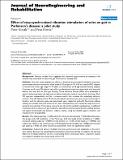| dc.description.abstract | Background: Previous studies have suggested that impaired proprioceptive processing in the striatum may contribute to abnormal gait in Parkinson's disease (PD). Methods: This pilot study assessed the effects of enhanced proprioceptive feedback using step-synchronized vibration stimulation of the soles (S-VS) on gait in PD. S-VS was used in 8 PD subjects (3 women and 5 men, age range 44–79 years, on medication) and 8 age-matched healthy subjects (5 women and 3 men). PD subjects had mild or moderate gait impairment associated with abnormal balance, but they did not have gait freezing. Three vibratory devices (VDs) were embedded in elastic insoles (one below the heel and two below the forefoot areas) inserted into the shoes. Each VD operates independently and has a pressure switch that activates the underlying vibratory actuator. The VD delivered the 70-Hz suprathreshold vibration pulse upon touch by the heel or forefoot, and the vibration pulse was deactivated upon respective push-offs. Six-minute hallway walking was studied with and without S-VS. Gait characteristics were measured using the force-sensitive foot switches. The primary outcome was the stride variability expressed as a coefficient of variation (CV), a measure of gait steadiness. Secondary outcome measures were walking distance and speed, stride length and duration, cadence, stance, swing and double support duration, and respective CVs (if applicable). Results: The walking speed (p < 0.04) and the CV of the stride interval (p < 0.02) differed between the groups and S-VS conditions. In the PD group, S-VS decreased stride variability (p < 0.002), increased walking speed (p < 0.0001), stride duration (p < 0.01), stride length (p < 0.0002), and cadence (p < 0.03). In the control group, S-VS decreased stride variability (p < 0.006) and increased gait speed (p < 0.03), but other locomotion parameters were not significantly altered. Conclusion: Augmented sensory feedback improves parkinsonian gait steadiness in the short-term setting. Because the suprathreshold stimulation prevented blinding of subjects, the learning effect and increased attention can be a confounding factor underlying results. Long-term studies are needed to establish the clinical value of the S-VS. | en_US |


